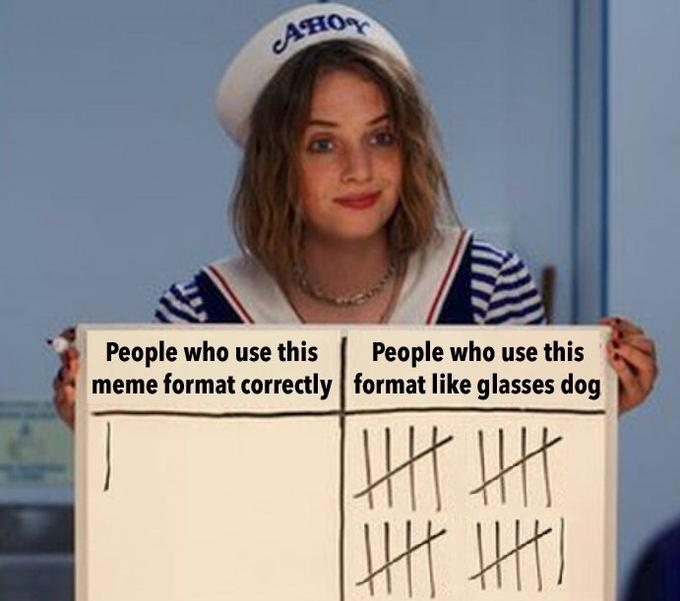Arthur Besse
cultural reviewer and dabbler in stylistic premonitions
- 7 Posts
- 41 Comments

 0·10 days ago
0·10 days ago
only hobbyists and artisans still use the standalone
carrot.pythat depends onpeeler.in enterprise environments everyone uses the
pymixedveggiespackage (created usingpip freezeof course) which helpfully vendors the latest peeled carrot along with many other things. just unpack it into a clean container and go on your way.

 7·2 months ago
7·2 months agoLemmy added an alt text field for image-only posts a few versions ago; it would be nice if more people would use it.
At least this post does link to the mastodon post which it is a screenshot of.

 0·3 months ago
0·3 months ago
ip -br a(
-bris short for-briefand makesip’saddr,link, andneighcommands “Print only basic information in a tabular format for better readability.”)

 0·5 months ago
0·5 months agothis isn’t remotely how this meme is used lol


 2·7 months ago
2·7 months agobecause i thought the situation described by the post was tragicomic (as was somewhat expressed by the line from it quoted in the post title)

 1·7 months ago
1·7 months agoYou can use Wireshark to see the packets and their IP addresses.
https://www.wireshark.org/download.html
https://www.wireshark.org/docs/
A word of warning though: finding out about all the network traffic that modern software sends can be deleterious to mental health 😬

 2·7 months ago
2·7 months agoI do have wireguard on my server as well, I guess it’s similar to what tailscale does?
Tailscale uses wireguard but adds a coordination server to manage peers and facilitate NAT traversal (directly when possible, and via a intermediary server when it isn’t).
If your NAT gateway isn’t rewriting source port numbers it is sometimes possible to make wireguard punch through NAT on its own if both peers configure endpoints for eachother and turn on keepalives.
Do you know if Yggdrasil does something similar and if we exchange data directly when playing over Yggdrasil virtual IPv6 network?
From this FAQ it sounds like yggdrasil does not attempt to do any kind of NAT traversal so two hosts can only be peers if at least one of them has an open port. I don’t know much about yggdrasil but from this FAQ answer it sounds like it runs over TCP (so using TCP applications means two layers of TCP) which is not going to be conducive to a good gaming experience.
Samy Kamkar’s amazing pwnat tool might be of interest to you.

 2·7 months ago
2·7 months agoI have a device without public IP, AFAIK behind NAT, and a server. If I use bore to open a port through my server and host a game, and my friends connect to me via IP, will we have big ping (as in, do packets travel to the server first, then to me) or low ping (as in, do packets travel straight to me)?
No, you will have “big ping”. bore (and everything on that page i linked) is strictly for tunneling which means all packets are going through the tunnel server.
Instead of tunneling, you can try various forms of hole punching for NAT traversal which, depending on the NAT implementation, will work sometimes to have a direct connection between users. You can use something like tailscale (and if you want to run your own server, headscale) which will try its best to punch a hole for a p2p connection and will only fall back to relaying through a server if absolutely necessary.

 5·7 months ago
5·7 months agoSee https://github.com/anderspitman/awesome-tunneling for a list of many similar things. A few of them automatically setup letsencrypt certs for unique subdomains so you can have end-to-end HTTPS.

 7·7 months ago
7·7 months agoMattermost isn’t e2ee, but if the server is run by someone competent and they’re allowed to see everything anyway (eg it’s all group chat, and they’re in all the groups) then e2ee isn’t as important as it would be otherwise as it is only protecting against the server being compromised (a scenario which, if you’re using web-based solutions which do have e2ee, also leads to circumvention of it).
If you’re OK with not having e2ee, I would recommend Zulip over Mattermost. Mattermost is nice too though.
edit: oops, i see you also want DMs… Mattermost and Zulip both have them, but without e2ee. 😢
I could write a book about problems with Matrix, but if you want something relatively easy and full featured with (optional, and non-forward-secret) e2ee then it is probably your best bet today.

 5·7 months ago
5·7 months agoTuta is most likely a honeypot, and in any case it is pseudo-open source so it’s offtopic in this community.
As the image transcript in the post body explains, the image at the bottom is a scene from a well-known 1998 film (which, according to Wikipedia, was in 2014 selected for preservation in the United States National Film Registry by the Library of Congress as being “culturally, historically, or aesthetically significant”).
This meme will not make as much sense to people who have not seen the film. You can watch the referenced scene here. The context is that the main character, The Dude (played by Jeff Bridges) has recently had his private residence invaded by a group of nihilists with a pet marmot (actually portrayed by a ferret) and they have threatened to “cut off his Johnson”. In an attempt to express sympathy, The Dude’s friend Walter (played by John Goodman) points out that, in addition to the home invasion and threats, the nihilists’ exotic pet is also illegal. The Dude’s retort “what, are you a fucking park ranger now” is expressing irritation with that observation, because it is insignificant compared with the threat of the removal of his penis.
This meme attempts to draw a parallel between this humorous scene and XZ developer Lasse Collin’s observation that the XZ backdoor was also a violation of Debian’s software licensing policies.
Thank you for reading my artist’s statement.

 1·8 months ago
1·8 months agoNot necessarily true - that right to modify/redistribute depends on the exact license being applied.
If you don’t have the right to modify and redistribute it (and to do so commercially) then it does not meet the definitions of free software or open source.
For example, the Open Watcom Public License claims to be an “open source” license, but it actually doesn’t allow making modifications.
The Sybase Open Watcom Public License does allow making modifications, and distributing modified versions. The reason why the FSF has not approved it is that it requires you to publish source code even if you only wanted to run your modified version yourself and didn’t actually want to distribute anything to anyone. (The Watcom license is one of the few licenses which is approved by OSI but not FSF. You can see the other licenses which are approved by one but not the other by sorting this table.)
The FSF’s own AGPL license is somewhat similar, but it only imposes the requirement if you run the software for someone else over a network. (Neither of these requirements are likely to be enforceable by copyright law, as I explained in my comment about the AGPL in the thread which this thread is about…)
This is also why we specifically have the terms “free software” or “FOSS” which imply they you are indeed allowed to modify and redistribute.
I would recommend reading this: https://www.gnu.org/philosophy/open-source-misses-the-point.en.html
I would recommend that you re-read that, because it actually explains that the two terms refer to essentially the same category of software licenses (while it advocates for using the term free software to emphasize the philosophical aspects of those licenses).

 1·8 months ago
1·8 months agoOpensource just means that the source code is available, FOSS however implies that you’re free to modify and redistribute the program
Incorrect. “Open Source” also means that you are free to modify and redistribute the software.
If the source code is merely available but not free to modify and/or redistribute, then it is called source-available software.

 1·8 months ago
1·8 months agoThanks. They are no longer a mod of this community. (I wrote this comment to them and they did not reply.)

 52·8 months ago
52·8 months agoHi @haui_lemmy@lemmy.giftedmc.com,
fyi icymi due to this thread someone posted this other thread asking “Is it appropriate for someone to be a mod here when they don’t understand open source, and insult users in the community?”.
I don’t have time to read all ~200 comments in these two threads, but I do think that being a moderator of /c/opensource@lemmy.ml requires knowing what FOSS is to be able to remove posts promoting things which are not.
Hopefully the replies here (again, I have not read even half of this thread…) have made you better informed?
In case you haven’t yet, I would highly recommend that you read these two documents (you can start with their wikipedia articles and follow links from there to the actual documents):
- https://en.wikipedia.org/wiki/The_Free_Software_Definition
- https://en.wikipedia.org/wiki/The_Open_Source_Definition
In short, the answer to your question (“Is there a License that requires the user to donate if they make revenue?”) is yes, there are many such licenses, but they are definitively not FOSS licenses (despite what some people who haven’t read the above definitions might try to tell you).
I won’t enumerate any of the non-FOSS licenses which attempt such a thing, because I recommend against the use of such licenses or software licensed under them.
BTW, I saw you wrote in another comment:
By now I get that FOSS mostly implies free work for corporations. I‘ll just go with agpl to ensure they get nothing from my work.
While corporations benefiting from FOSS while failing to financially support it at all is extremely commonplace, I vehemently disagree that that is what FOSS “mostly implies”. In fact, the opposite is more common: the vast majority of free software users are not paying anything to the companies who have paid for an enormous amount of the development of it. A few hundred companies pay tens of thousands of individual developers to develop and maintain the Linux kernel, for instance.
Regarding the second sentence of yours that I quoted above, in case you haven’t understood this yet: the AGPL does not prevent commercial use of your work. If you write a web app and license it AGPL, you are giving me permission to run it, modify it, redistribute my modified version, and to charge money for it without giving you anything.
What the AGPL does, and why many companies avoid it, is impose the requirement that I (the recipient of your software) offer the source code to your software (and any modifications I made to it) under that same license not only to anyone I distribute it to but also to anyone using the software over a network on my server.
If the software were licensed GPL instead of AGPL, I would only be required to offer GPL-licensed source code to people when I distribute the software to them. Eg, I could improve a GPL web app and it is legal to not share my improvements (to the server-side code) with anyone at all because the software is not being distributed - it is just running on my server.
By imposing requirements about how you run the software (eg, if you put an AGPL notice in the UI, I am not allowed to remove it) the AGPL is more than just a copyright license: violations of the GPL and most FOSS licenses are strictly copyright violations and can be enforced as such, but violating the part of the AGPL where it differs from the GPL would not constitute copyright infringement because no copying is taking place. Unlike almost every other FOSS license, the AGPL is both a copyright license and a end-user license agreement.
For this reason, many people have misgivings about the AGPL. However, if you want to scare companies away from using your software at all (and/or require them to purchase a different license from you to use it under non-AGPL terms, which is only possible if you require all contributors to assign copyright or otherwise give you permission to dual-license their work) while still using a license which the FOSS community generally accepts as FOSS… AGPL is probably your best bet.
HTH.
p.s. I’m not a lawyer, this isn’t legal advice, etc etc :)

